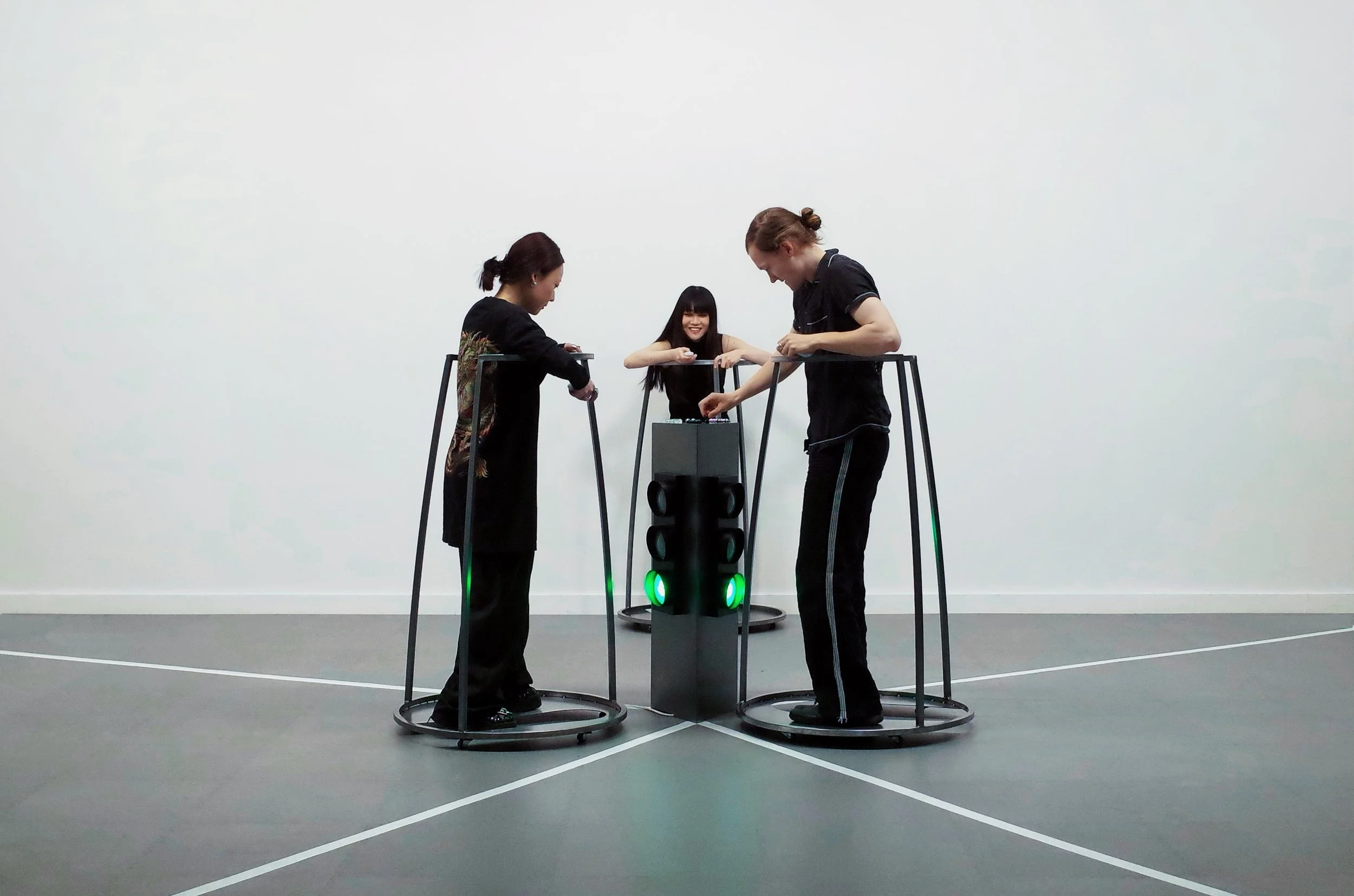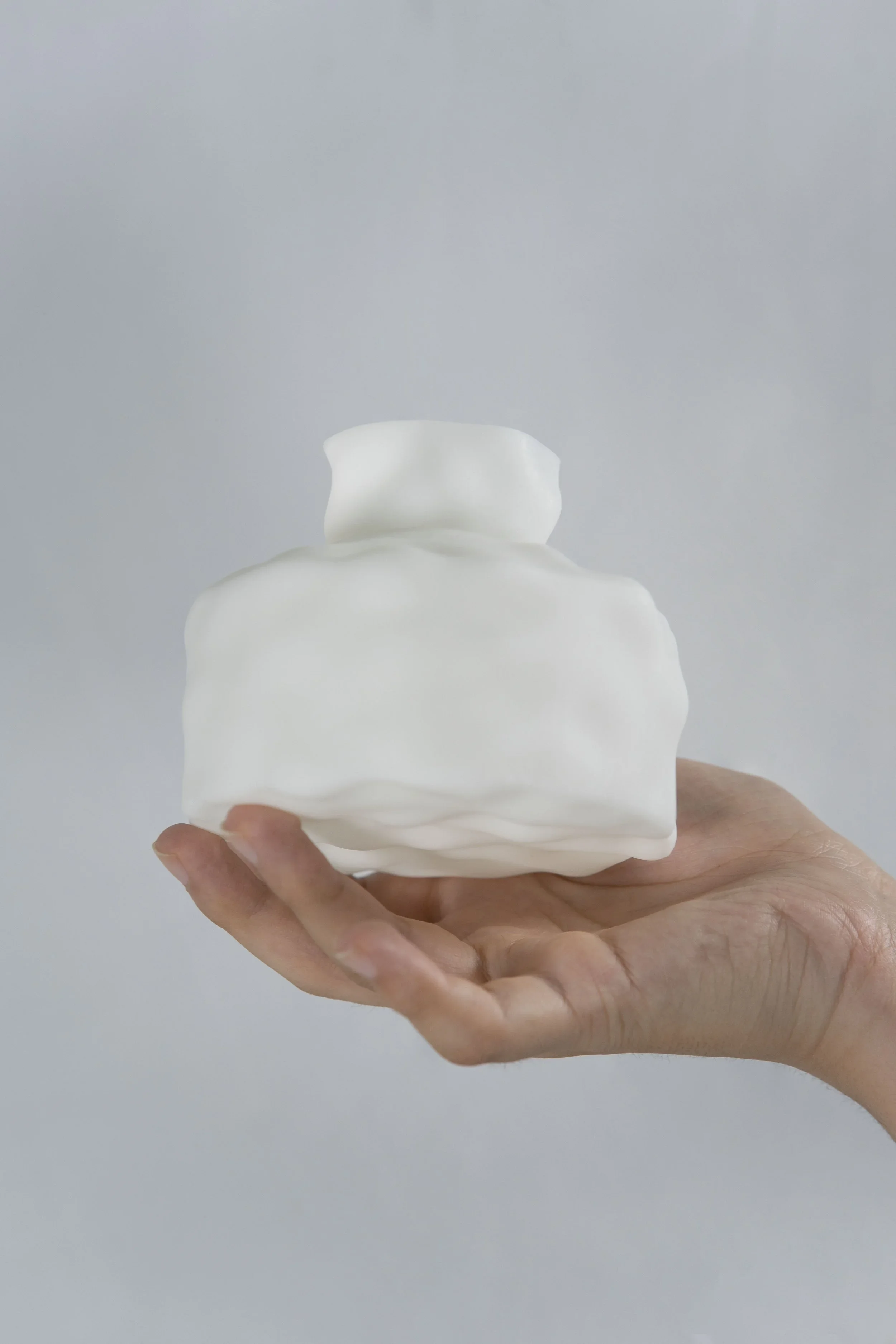10 Questions with Hyoju Cheon
Hyoju Cheon (b.1994, Seoul) is an explorer and interdisciplinary artist currently residing in New York. Her multimedia practice–often casting a space, an object, or a body in motion–responds to the conditions of a site. Her work documents bodies as they move through space: drawing their trajectories and archiving the material traces left behind. Hyoju has exhibited her works in Seoul at Dongsomun, Meindo, Gallery Imazoo, and Gaon Gallery; and in New York at the Lenfest Center for the Arts, the Abrons Arts Center, Half Gallery, and Chashma, among others.
Hyoju Cheon - Portrait
ARTIST STATEMENT
“My practice recently has involved creating surrogates and obstructions for my body, recording my movements as kinetic loops, and measuring wear and erosion in handfuls of dust.
Shape — whether simple, geometric, body-like, or formed out of indentation of our bodies — is crucial to my work and creates a space between verbal and nonverbal. In my sculpture, semiotic elements can be found, usually mirroring the environment or architecture around me.
This practice — often casting a space, an object, or a body in motion — responds to the conditions of a site. I’m interested in domestic spaces that are often overlooked despite being a place where one may spend much of their time. The inconspicuous nooks in walls, the floors, and the corners are the points of departure for my installations. My work often emphasizes their presence and materiality, and together- I, my body, and the space interact with each other.”
— Hyoju Cheon
Unnecessary thing we carry, Homo motus, drawing, pencil on paper, 2019 © Hyoju Cheon
INTERVIEW
Let's talk about yourself first. Why are you an artist, and how did you become one?
Since a young age, I've always loved creating and expressing myself through art. Whether it's painting, sketching, or turning my thoughts into something tangible, it's always fascinated me. As time went on, I kept searching for ways to bring my ideas to life. It's become a major driving force in my life, pushing me to explore different mediums and techniques to bring my imagination to reality. And here I am today, still going strong in the creative process. It's a fundamental part of who I am, and I'm always working hard to improve my skills and push the limits of my artistic abilities.
You already have an impressive career, with exhibitions in South Korea and New York. What is your favorite memory as an artist so far?
One of the most cherished aspects of being an artist is the opportunity to connect with other artists whose work resonates with me. Building relationships with these artists and delving into their creative processes is an invaluable experience. I am genuinely grateful for the chance to not only witness their artwork but also to understand the artists themselves on a deeper level. Discovering the background stories, their artistic journeys, and the inspirations behind their work adds a whole new dimension to my appreciation.
Mapping without scale, drawing, pencil, water color on paper © Hyoju Cheon
Mapping without scale, Performance with object © Hyoju Cheon
How would you define yourself as an artist? And how has this definition changed over the years?
I would define myself as an artist who strives to evoke memories, unnoticed feelings, and aspects of our lives in people. However, this definition has evolved over time. In the early stages of my art career, I was fascinated by elements that make us more human. In a fast-paced world, I discovered the significance of seemingly meaningless or inefficient things for people in the present time. This led me to explore activities and movements that may appear purposeless, such as daydreaming, gazing at the sky, or engaging in repetitive motions with no immediate outcomes.
Later on, my focus shifted towards examining how our bodies interact with the surrounding environment and the objects we encounter. I began collecting everyday gestures and objects, which eventually expanded into incorporating automated movements driven by motors. I questioned whether these automated movements are more efficient than human actions.
In my most recent work, I have been exploring the concept of intuitive movement, drawing inspiration from the natural way children move. However, at the core of my artistic pursuits lies a heartfelt desire to evoke and connect with the inner child within all individuals, evoking their authentic emotions and feelings.
You are an interdisciplinary artist, mainly working with sculpture and installation. Why did you choose these mediums? And what do they represent for you?
I'm really into sculpture and installation work. What I love about them is the tactile nature they bring to space. It's amazing how, when I create sculptures or experiment with materials, I get to experience them while they also interact with my body. The materials I use, like sand, wood, and fabric, always end up carrying traces of my body, and that truly fascinates me. That's why I continue making sculptures. Over time, my medium expanded to include installations. It happened naturally as I started incorporating different elements like performance, video, and sound. When I would perform with objects, they would naturally create sounds, and that made me want to incorporate sound elements into my sculptures. So, it gradually evolved into more of an experiential installation.
Slow down to nothing, casting plaster, sanding machine, 2022 © Hyoju Cheon
In your work, you focus primarily on your body, which you use as your main subject. How did you come up with this idea? And why did you choose your body specifically?
I use my body because it's the tool I have to express myself freely through movement, dance, and performance. It has become my main subject naturally, but I also hope to involve other bodies in my work in the future. Since 2019, I have been exploring performance, and during that time, I studied painting on larger canvases that were taller than me. I soon realized that to paint on such a scale, I needed to use my entire body, not just my arms or hands. That was a pivotal moment for me, and it solidified my decision to pursue performance art. As I delve into performance, I'm curious to see how my body interacts with the materials I work with and the environments I encounter. Naturally, my body has become the primary resource for my observations and studies.
How has your art evolved over the years? And what inspired you to experiment?
I feel like my work has evolved in terms of both mediums and my interests. Initially, I focused on painting, but then I ventured into performances and gradually incorporated sculpture, sound, and video based on those performances. It's been fascinating to reflect on how my work has transformed over time.
With each new project, I explore different materials because I believe they contribute to the overall desired feeling. Depending on the specific emotion or concept I want to convey, the materials I choose change accordingly. I draw inspiration from stories shared by my friends, everyday life scenes, as well as music and dance. I start by envisioning a particular feeling or situation and experimenting with materials that can capture that essence. Once I have a clear draft, I move on to the production process, occasionally revisiting experimentation and refining until I achieve the desired sculptural expression. It's a fluid and iterative journey.
R2023. How can we measure our sigh, 2022 © Hyoju Cheon
Performance with object © Hyoju Cheon
What is ultimately the message you want to convey to the viewers? And what do you think differentiates your approach from others?
It's challenging to define my intention as conveying just one singular meaning to the world. Rather, I strive to share the memories I have experienced or long for. Deep within my work, there is always a young child who fearlessly engages with their surroundings, unafraid to touch or explore, while also showing care for others.
I believe that my ultimate goal in creating this work is to enable people to reconnect with their inner child and experience that sense of wonder once again.
You have exhibited extensively. What do you think of the art community and market? And how do you keep your collectors and peers engaged with your art?
In the art world, and even in general, maintaining connections with peers and communities is crucial. I believe that honesty and sharing personal experiences and stories are important in this regard. When you are open and authentic, it captures the attention of the art community and even the market, as they become more willing to listen to and engage with your message. While I acknowledge that there is still much for me to discover and learn, I strive to remain open and receptive, inviting others to engage in meaningful conversations about my work.
Trajectory of my body, vinyl, sand, runner hose, plaster, moss © Hyoju Cheon
What are you working on now? Do you have any new projects or exhibitions you want to tell us about?
I am currently immersed in a new series of my work, which revolves around the concept of intuitive movements. At the moment, I am participating in the Kunstraum residency program in Brooklyn, where I have been given the opportunity to further develop my artistic practice.
Additionally, I am thrilled to announce that in June, I will be part of a two-person show at Subtitled NYC with amazing artist Yixuan.
What I find particularly intriguing about this collaboration is that while Yixuan and I share common interests, we also bring our unique perspectives to the show, resulting in a diverse exploration of the interaction between humans and objects. We each have our own distinct way of perceiving and interpreting the world around us, and this juxtaposition adds depth and richness to our exhibition.
I am genuinely excited about showcasing my latest body of work, and I cordially invite you to experience it firsthand.
And lastly, where do you see yourself and your work five years from now?
In the next five years, I envision my work evolving into a more immersive and interactive experience. It is crucial for me to create opportunities for people to engage and interact with my art. Looking ahead in the long term, I am eager to explore and experiment with new materials, aiming to establish a space where individuals can comfortably interact with my artwork.
On a personal level, I have a strong desire to visit the locations where I have exhibited this year. It would be fulfilling to see these spaces firsthand and gain a deeper understanding of their context.
Artist’s Talk
Al-Tiba9 Interviews is a promotional platform for artists to articulate their vision and engage them with our diverse readership through a published art dialogue. The artists are interviewed by Mohamed Benhadj, the founder & curator of Al-Tiba9, to highlight their artistic careers and introduce them to the international contemporary art scene across our vast network of museums, galleries, art professionals, art dealers, collectors, and art lovers across the globe.























